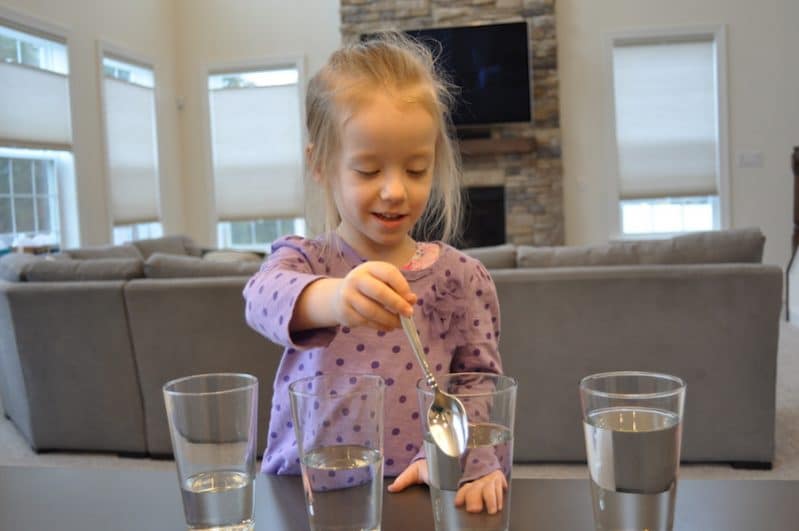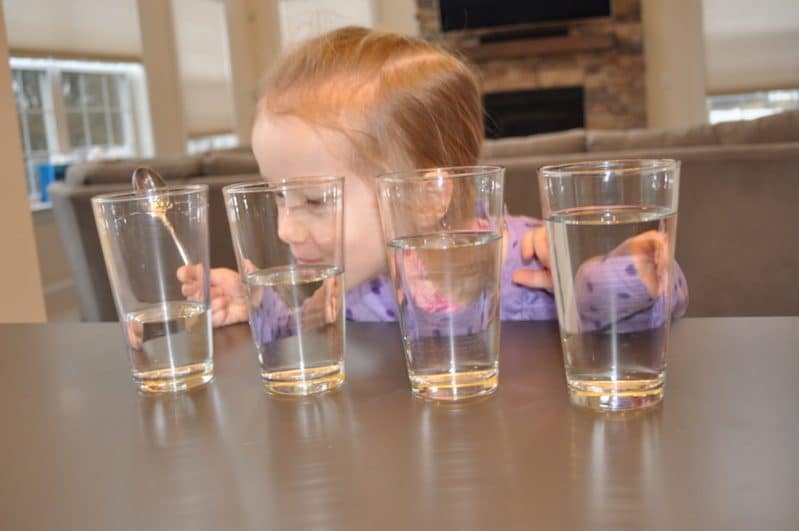
Click here to read Science Experiment: Make Music with Water on Hands On As We Grow
Learn how to make music with water in this super simple classic science experiment from Rachel.
All you need for this classic science experiment is a few matching glasses, a spoon and water. It doesn’t get much simpler than that!
Check out these other super easy set-up activities!
I don’t know about you, but I remember doing this experiment when I was a kid, both at home and in school. It is a really fun and easy way to explore the science of sound!
How to Make Music with Water
It’s honestly super simple. Grab a few glasses.
Make sure they are the roughly the same size. It makes everything work a little better.
Now, fill the glasses with different amounts of water. You could get super accurate here and measure the water if you want to try to create specific notes/pitches.
I just filled a pitcher and had Hannah help me pour a little in one, more in the next, etc.
Last, I gave Hannah a spoon and showed her how to tap it on the glass. If you have a really young child or a very enthusiastic one, I would use a plastic spoon to minimize the risk of breakage.
I knew Hannah would be fine, so we just used a metal cereal spoon.
Make Music with Water Science:
Tapping the spoon on the glass creates a vibration sending a sound wave through the water in the glass. Each glass makes a different sound because the sound wave travels at different speeds through the water.
The speed of the sound wave depends on the amount of water in the glass.
The glass with the most water makes the lowest sound because the sound waves travel the slowest. The glass with the least water makes the highest sound because the sound waves travel the fastest.
An older child might be really interested in a simple explanation of sound waves and how they work.
For Hannah, we compared the sounds each glass made and the amount of water in each glass. I knew she wouldn’t understand what a “high” or “low” sound was, so I called the low sound “big” and the high sound “little.”
Not scientifically accurate, but much more in her realm of understanding.
What Happened When We Made Music with Water
We went through the experiment several times, tapping each glass, looking at the amounts of water, and comparing.
She was able to see the connection between the amount of water and the sounds pretty quickly. The glass with lots of water made a big sound, and the glass with a little water made a little sound.
After that, she went to town! I showed her how to tap the glasses randomly (up until now we were tapping them in order) to make music with water.
She took over and played her glasses for much longer than I expected.
At this point, if you do your research and measure your water accurately, you can play actual songs.
We were going for the exploration, so I didn’t worry about this, but older kids especially might love learning to play a song they know.
It’s been a long time since we did any experiments in our house. This reminded me how much the kids and I both love them!
We will definitely be turning the kitchen into a lab again soon.
What activity from your childhood have you done with your kids?




No comments:
Post a Comment